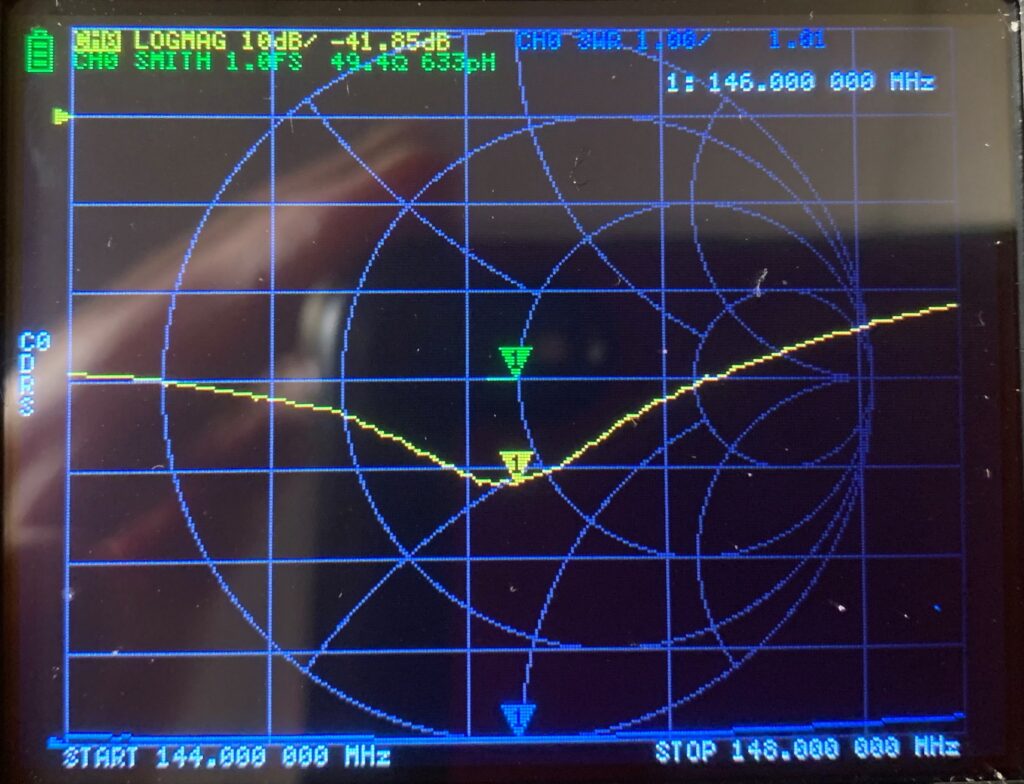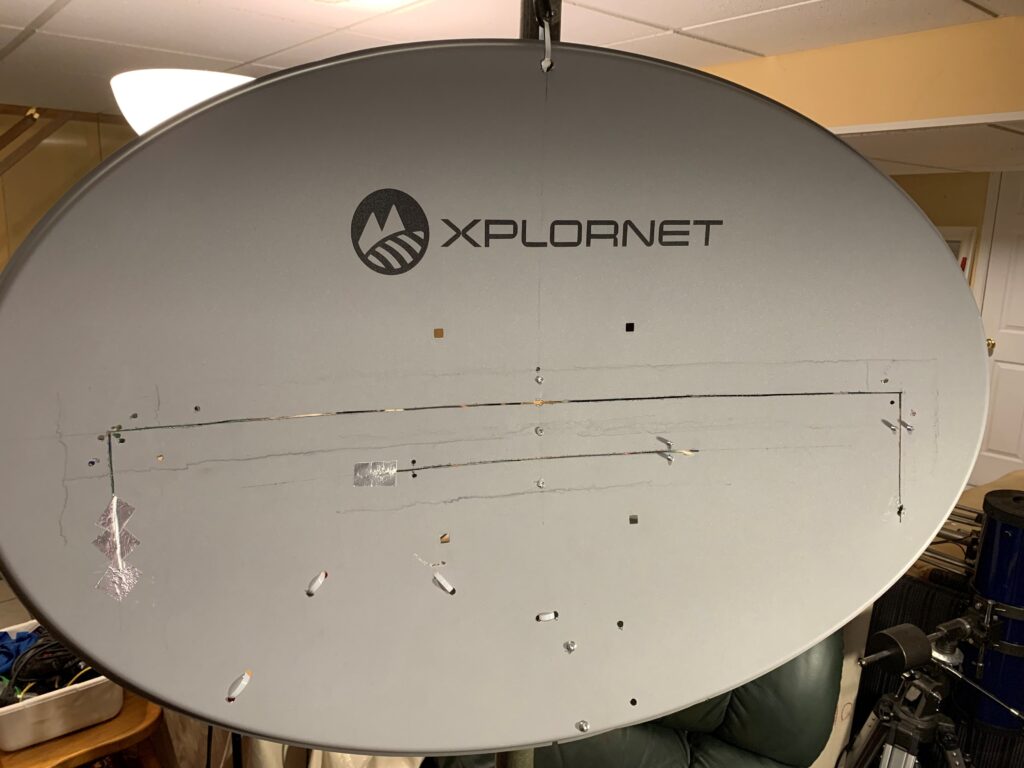With a surplus satellite dish on my hands as a result of an internet upgrade, I began to look around for a potential amateur radio use. I was inspired to by Marcel Stieber’s (AI6MS) presentation “Dual-Band Satellite Dish Slot Antenna” who was in turn inspired by John Portune (W6NBC), guru of all-things-slot-antenna.
The lessons learned identified by Marcel Stieber (AI6MS) in his presentation included: 1) Place the slots as close to the centre of the satellite dish as possible for an even vertical radiation pattern; 2) Remove the satellite dish feedhorn to reduce potential interference; 3) Multi-band slots on the same satellite dish don’t appear to interference with performance, and 4) The use of a single feed-point for both slots or the use of Y-coax harness to feed with different phased lengths of coax are possible adaptations to avoid the use of a duplexer in the design of the dual band antenna.
An additional reason for undertaking this project was to explore first-hand how slot antennas function (“How a hole be an antenna”) and explore possible applications. At a technical level the idea that a horizontal dipole shaped hole in a piece of metal could be fed to radiate an RF signal with a vertical polarization was kind of intriguing! The Antenna-Theory.com section of the reference below provided a good overview of why a slot antenna radiates RF in the way it does.
The 2M Build: Based on the calculations for a half-wave dipole, a slot of 103 cm (λ/2 = 150/146 = 1.027M or 102.7cm or 103cm) was cut with 76 cm horizontally and two downward vertical cuts at each end of 13.5 cm. A feed point was calculated (936/146 x 0.6 = 3.8466 or 9.77cm, which I rounded to 10cm) and two holes were drilled for a feed-point within .5cm on each side of the right vertical slot 10cm up from the bottom. The slot was made by determining the centre of the dish vertically and horizontally and drawing out in pencil the centre line for the 2M slot, as this would be the main intended use with the 70 cm slot being centred horizontally falling 5.5 cm below the vertical median line of the 2M slot. Given that the surface I was drawing on was concave my metal carpenters tape measure wasn’t very effective and I had to resort to borrowing my wife’s fabric measuring tape which could more effectively measure out the slot lines. A standard fine tooth metal jigsaw blade was used to cut the slot one blade width wide between starter holes drilled at each end of the horizontal slot facilitating cutting both the larger horizontal section and the two small downward “legs” to make up the entire distance. A small wooden brace was used in the centre to help keep the upper and lower sections a relatively uniform distance apart.
A short length of LMR 195 was used to connect the braid and centre connector to each side of the slot, with some plastic tape to avoid shorting the braid across the slot. Six turns of LMR 195 in a 16cm loop was used as a current balun. For testing the satellite dish it was suspended about 1M from the floor in my basement. An initial check on my NanoVNA indicated a VSWR of 2.0 at 146MHz.
With the NanaoVNA inline, pieces of aluminum adhesive tape were added to cover the vertical leg of the slot opposite to the feed-point, until the Smith Chart indicated a tight arc around the system impedance point with a VSWR of less than 1.5 across 144-148 MHz. The result was a 2M slot length of 94.7cm, while maintaining the 10 cm feed-point at the opposite end. Aluminum tape was applied to both sides of the dish to strengthen and provide better electrical connections across the slot.
As a transmission test with an HT connected inline with a VSWR meter it was possible to reach several local repeaters with 3 watts and a VSWR of 1.02 from my basement. Given that one intended application for this antenna was to be used in an attic for local repeaters, these signs of effective performance were encouraging. The slot antenna may be well suited to this purpose, particularly for smaller attics given its horizontal orientation with vertical polarization appropriate for local 2M FM repeaters.
The 70 cm Build: For a half-wavelenth 70cm band slot of 33.7cm (λ/2 = 150/445 = 0.3370M or 33.7cm) was cut just below the 2M slot with two holes drilled for a feedpoint at 3.20 cm (936/445 x 0.6 = 1.26 inches or 3.20cm). Initial testing with a NanoVNA indicated a VSWR less than 2, but there was room for improvement, so pieces of aluminum tape were added to slot end opposite the feed-point until a maximum performance on the Nano VNA could be determined (see below). The 70cm slot was reduced by 2 cm to 31.7cm with the aluminum tape covering the slot to produce a VSWR rating of less than 1.6 across 430-450 MHz.
When I next have a surplus satellite dishe I plan to try out an alignment of the 2M/ 70cm slots that may permit the use of a single feed-point or possibly maintain the current design and figure out, with the help of club members, how I might use my NanoVNA to determine a phased length of coax for a Y-Coax harness for both 2M and 70cm feed-lines.



73, Alan VA3IAH
Appears in: Rambler Vol. 55 Issue 5 January 2023
REFERENCE LINKS:
Other non-radio re-purposing ideas for a satellite dish:
Marcel Stieber (AI6MS)
- “Dual-Band Satellite Dish Slot Antenna”, March 2021, Virtual Ham Expo, https://vimeo.com/523480920
John Portune (W6NBC)
- Slot Antennas for Ham radio: The Forgotten Antenna (Kindle book) https://www.amazon.ca/Slot-Antennas-Ham-Radio-Forgotten-ebook/dp/B08D8LC9HP
- Slot Antennas: How can a hole be an Antenna, https://www.youtube.com/watch?v=MNqqvYlifyw
- An Efficient 2 Meter Antenna Disguise as a TV Satellite Dish http://www.w6nbc.com/articles/2016-3QSTdishslot.pdf and https://w6nbc.com/articles/20xx-dishslot.pdf
- A Durable, Low Profile 2-Meter Mobile Antenna http://www.w6nbc.com/articles/2018-03QSTdesigncompetition.pdf
Slot Antenna Theory:
- https://www.antenna-theory.com/antennas/aperture/slot.php
- https://youtu.be/dI6e4ZR9Oi8
- https://www.youtube.com/watch?v=iefZnZnh8Wc
Smith Chart:
- Basics of Smith Chart and Antenna Measurement, Alan Wolke, W2AEW: https://www.youtube.com/watch?v=kOEw6A8CovE
